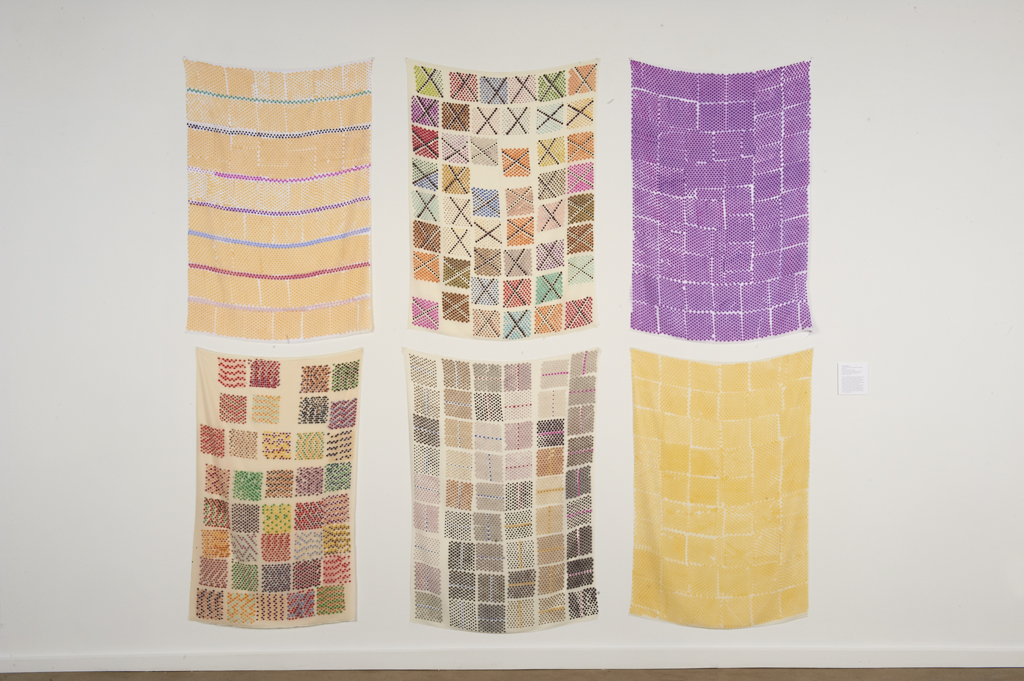That's a Wrap: Post-Exhibiton Review of "Tie Up, Draw Down" at the Center for Craft, Creativity, and Design (Asheville, NC)
by Arden Cone
The shuttle and the loom.
The weft and warp threads.
The tying up and drawing down of simple strands.
Working in unison, they perform a humble ode to humanity. Their movements accumulate to form the most basic textiles that have assured our species’ survival for millennia, the literal fabrics of our lives.
The practice of weaving has evolved alongside humans since 700 BC, and for the past three months, and it has reached its acme at the Center for Craft, Creativity and Design’s (CCCD) current show, Tie Up, Draw Down.
The exhibition, curated by CCCD Curatorial Fellows Natalie Campbell and Carissa Carmen, displays the work of fifteen contemporary artists in its Benchspace Gallery and Workshop in Asheville, NC. The artists, including, Polly Apfelbaum, Joell Baxter, Jen Bervin, Francesca Capone, Liz Collins, Marianne Fairbanks, Del Harrow, Shiela Hicks, LoVid, John Paul Morabito, Danielle Mysliwiec, Meghan Price, Molly Smith, Laurel Sparks, and Margo Wolowiec, have experimented with, adapted, and refashioned ideas of how weaving fits into the language of contemporary art.
Joell Baxter, Waver (hanging), 2017. Screenprinted paper, hand cut and woven; glue, wood 108 x 155 x 1½ inches. Installation view, The Center for Craft, Creativity & Design, 2017. Photo: Steve Mann, Black Box Photography.
The show offers, immediately upon entrance, a pleasing range in the scale of works. Two large pieces by Joell Baxter and Liz Collins call upon their formal strengths of line and color to warrant the large areas of space they occupy. Though the loose paper weave of Baxter’s, Waver, allows the viewer to see through to the space beyond it, the work is an impasse, hanging down from the ceiling and blocking off the diagonal path I might have taken to approach four framed works by Meghan Price. Together with the twelve horizontal strands making up Collins’ installation, Aqueducts, it forms an adjacent barrier that seems to safeguard Price’s beautifully understated works, each on white paper, in white frames, on the white wall.
Liz Collins, Aqueducts, 2017. Yarn, drywall, plywood, mixed media. Dimensions variable. Installation view, The Center for Craft, Creativity & Design, 2017. Photo: Steve Mann, Black Box Photography.
Del Harrow’s tall sculpture, Cactus Kourous, functions in a similar manner. Its body-like mass can be broken into threes: a top, a middle, and a bottom section, each with limbs weaving their way through space like magnified threads. Visible beneath its thin, green skin, however, is its ceramic skeleton. Hundreds of coils in continuous strands show that the work is an accumulation of smaller movements.
Del Harrow, Cactus Korous 2, 2016. Earthenware, glaze, luster. 73 x 19 x 19 inches. Installation view, The Center for Craft, Creativity & Design, 2017. Photo: Steve Mann, Black Box Photography.
Even the artworks that, like Harrow’s, that aren’t constructed with traditional fiber materials give a nod to the fact that weaving is a slow amassment of smaller strands. Through the accumulation of material comes an accumulation of meaning, and, with each successive coil, Harrow’s work becomes weightier in appearance and concept.
Danielle Mysliwiec, Drawn, 2017. Oil on linen-covered wood panels. 96 x 14 inches each. Installation view, The Center for Craft, Creativity & Design, 2017. Photo: Steve Mann, Black Box Photography
A large diptych by Danielle Mysliwiec is another experience of mass and amassment. It hits the senses with blunt force— large, black, and heavy. The piece does not look oppressive, thanks to the delicate “weaves” of oil paint on its surface, but it certainly floods the olfactory senses. The smell of its pigments is its tangible aura.
Of all the artists in the show Polly Apfelbaum represented the exhibition’s theme of weaving most straightforwardly. She drew it. By putting marker to velvet and drawing matrixes of dots, she depicts patterns inspired by Marguerite Porter Davison’s A Handweavers Pattern Book (1944). The six resulting drawings consume the back wall of the gallery. Each is systematically and geometrically composed, but, together in their installation, they speak not of structure, rather, lack thereof.
Polly Afelbaum, Untitled (from the series A Handweaver's Pattern Book), 2014, Marker on synthetic silk velvet, 6 elements, each approximately 59 x 40 inches. Courtesy of the artist and Alexander Gray Associates, New York. Installation view, The Center for Craft, Creativity & Design, 2017. Photo: Steve Mann, Black Box Photography.
Structure implies solidity, and Apfelbaum’s choice of material results in nothing of that nature. The drawings, rendered on cheap, thin, velvet, hang loosely from only two thumbtacks in the top corners. They sag in the middle, which demolishes the grids on their surface to a point of amusement. As I walk beside them, they respond to my body, swaying a bit in the airflow. It is nearly a tactile experience, and suddenly I long to touch the shiny velvet surfaces.
Tie Up, Draw Down satisfies on a sensual level, fully engaging the viewer’s capacities of sight, smell, sound, and touch. These are the experiences we comprehend upon walking into a gallery, but great shows transcend this. This exhibition does just that, hijacking the viewer by his or her sensory experience and translating that input into higher thinking about weaving in contemporary art.
Views of works by Polly Apfelbaum, Marianne Fairbanks, and Danielle Mysliwiec. Installation view, The Center for Craft, Creativity & Design, 2017. Photo: Steve Mann, Black Box Photography.
This exhibition took place between June 2nd and September 2nd, 2017.





